Standard [CURRENT]
ASTM E 3397:2023
Standard Practice for Resonance Testing Using the Impulse Excitation Method
- Publication date
- 2023
- Original language
- English
- Pages
- 14
- Publication date
- 2023
- Original language
- English
- Pages
- 14
- DOI
- https://dx.doi.org/10.1520/E3397-23
Product information on this site:
Quick delivery via download or delivery service
Buy securely with a credit card or pay upon receipt of invoice
All transactions are encrypted
Short description
1.1 This practice covers a general procedure for using the Impulse Excitation Method (IEM) to facilitate natural frequency measurement and detection of defects and material variations in metallic and non-metallic parts. This test method is also known as Impulse Excitation Technique (IET), Acoustic Resonance Testing (ART), ping testing, tap testing, and other names. IEM is listed as a Resonance Ultrasound Spectroscopy (RUS) method. The method applies an impulse load to excite and then record resonance frequencies of a part. These recorded resonance frequencies are compared to a reference population or within subgroups/families of examples of the same part, or modeled frequencies, or both. 1.2 Absolute frequency shifting, resonance damping, and resonance pattern differences can be used to distinguish acceptable parts from parts with material differences and defects. These defects and material differences include, cracks, voids, porosity, material elastic property differences, and residual stress. IEM can be applied to parts made with manufacturing processes including, but not limited to, powdered metal sintering, casting, forging, machining, composite layup, and additive manufacturing (AM). 1.3 This practice is intended for use with instruments capable of exciting, measuring, recording, and analyzing multiple whole body, mechanical vibration resonance frequencies in acoustic or ultrasonic frequency ranges, or both. This practice does not provide inspection acceptance criteria for parts. However, it does discuss the processes for establishing acceptance criteria specific to impulse testing. These criteria include frequency acceptability windows for absolute frequency shifting, scoring criteria for statistical analysis methods (Z-score), Gage Repeatability & Reproducibility (R&R) for diagnostic resonance modes, and inspection criteria adjustment (compensation) for manufacturing process and environmental variations. 1.4 This practice uses inch pound units as primary units. SI units are included in parentheses for reference only and are mathematical conversions of the primary units. 1.5 This standard does not purport to address all of the safety concerns, if any, associated with its use. It is the responsibility of the user of this standard to establish appropriate safety, health, and environmental practices and determine the applicability of regulatory limitations prior to use. 1.6 This international standard was developed in accordance with internationally recognized principles on standardization established in the Decision on Principles for the Development of International Standards, Guides and Recommendations issued by the World Trade Organization Technical Barriers to Trade (TBT) Committee.
ICS
17.140.01
DOI
https://dx.doi.org/10.1520/E3397-23
Also available in
Loading recommended items...
Loading recommended items...
Loading recommended items...

